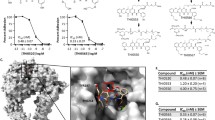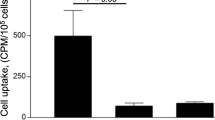Abstract
Purpose
Macrophage plays an important role in plaque destabilization in atherosclerosis. By harnessing the affinity of macrophages to certain phospholipid species, a liposomal contrast agent containing phosphatidylserine (PS) and X-ray computed tomographic (CT) contrast agent was prepared and evaluated for CT imaging of plaque-associated macrophages in rabbit models of atherosclerosis.
Procedures
Liposomes containing PS and iodixanol were evaluated for their physicochemical characteristics, in vitro macrophage uptake, in vivo blood pool clearance, and organ distribution. Plaque enhancement in the aorta was imaged with CT in two atherosclerotic rabbit models.
Results
In vitro macrophage uptake of PS liposomes increased with increasing amount of PS in the liposomes. Overall clearance of PS liposomes was more rapid than control liposomes. Smaller PS liposomes (d = 112 ± 4 nm) were more effective than control liposomes of similar size or larger control and PS liposomes (d = 172 ± 17 nm) in enhancing aortic plaques in both rabbit models.
Conclusions
Proper liposomal surface modification and appropriate sizing are important determinant for CT-based molecular imaging of macrophages in atheroma.




Similar content being viewed by others
References
Ross R (1999) Atherosclerosis is an inflammatory disease. Am Heart J 138:S419–S420
Shah PK, Falk E, Badimon JJ et al (1995) Human monocyte-derived macrophages induce collagen breakdown in fibrous caps of atherosclerotic plaques. Potential role of matrix-degrading metalloproteinases and implications for plaque rupture. Circulation 92:1565–1569
Leuschner F, Nahrendorf M (2011) Molecular imaging of coronary atherosclerosis and myocardial infarction: considerations for the bench and perspectives for the clinic. Circ Res 108:593–606
Hyafil F, Cornily JC, Feig JE et al (2007) Noninvasive detection of macrophages using a nanoparticulate contrast agent for computed tomography. Nat Med 13:636–641
Hyafil F, Cornily JC, Rudd JH et al (2009) Quantification of inflammation within rabbit atherosclerotic plaques using the macrophage-specific CT contrast agent N1177: a comparison with 18F-FDG PET/CT and histology. J Nucl Med 50:959–965
Van Herck JL, De Meyer GR, Martinet W et al (2010) Multi-slice computed tomography with N1177 identifies ruptured atherosclerotic plaques in rabbits. Basic Res Cardiol 105:51–59
Bhavane R, Badea C, Ghaghada KB et al (2013) Dual-energy computed tomography imaging of atherosclerotic plaques in a mouse model using a liposomal-iodine nanoparticle contrast agent. Circ Cardiovasc Imaging 6:285–294
Elrod DB, Partha R, Danila D et al (2009) An iodinated liposomal computed tomographic contrast agent prepared from a diiodophosphatidylcholine lipid. Nanomedicine 5:42–45
Fadok VA, Bratton DL, Rose DM et al (2000) A receptor for phosphatidylserine-specific clearance of apoptotic cells. Nature 405:85–90
Krahling S, Callahan MK, Williamson P, Schlegel RA (1999) Exposure of phosphatidylserine is a general feature in the phagocytosis of apoptotic lymphocytes by macrophages. Cell Death Differ 6:183–189
Klibanov AL, Maruyama K, Beckerleg AM et al (1991) Activity of amphipathic poly(ethylene glycol) 5000 to prolong the circulation time of liposomes depends on the liposome size and is unfavorable for immunoliposome binding to target. Biochim Biophys Acta 1062:142–148
Chiu GN, Bally MB, Mayer LD (2001) Selective protein interactions with phosphatidylserine containing liposomes alter the steric stabilization properties of poly(ethylene glycol). Biochim Biophys Acta 1510:56–69
Geelen T, Yeo SY, Paulis LE et al (2012) Internalization of paramagnetic phosphatidylserine-containing liposomes by macrophages. J Nanobiotechnol 10:37
Moore KJ, Tabas I (2011) Macrophages in the pathogenesis of atherosclerosis. Cell 145:341–355
Van Vre EA, Ait-Oufella H, Tedgui A, Mallat Z (2012) Apoptotic cell death and efferocytosis in atherosclerosis. Arterioscler Thromb Vasc Biol 32:887–893
Saitoh S, Saito T, Ohwada T et al (1998) Morphological and functional changes in coronary vessel evoked by repeated endothelial injury in pigs. Cardiovasc Res 38:772–781
van Bochove GS, Paulis LE, Segers D et al (2011) Contrast enhancement by differently sized paramagnetic MRI contrast agents in mice with two phenotypes of atherosclerotic plaque. Contrast Media Mol Imaging 6:35–45
Mulder WJ, Douma K, Koning GA et al (2006) Liposome-enhanced MRI of neointimal lesions in the ApoE-KO mouse. Magn Reson Med 55:1170–1174
Maiseyeu A, Mihai G, Kampfrath T et al (2009) Gadolinium-containing phosphatidylserine liposomes for molecular imaging of atherosclerosis. J Lipid Res 50:2157–2163
Ogawa M, Umeda IO, Kosugi M et al (2014) Development of 111In-labeled liposomes for vulnerable atherosclerotic plaque imaging. J Nucl Med 55:115–120
Ruehm SG, Corot C, Vogt P et al (2001) Magnetic resonance imaging of atherosclerotic plaque with ultrasmall superparamagnetic particles of iron oxide in hyperlipidemic rabbits. Circulation 103:415–422
Schmitz SA, Coupland SE, Gust R et al (2000) Superparamagnetic iron oxide-enhanced MRI of atherosclerotic plaques in Watanabe hereditable hyperlipidemic rabbits. Invest Radiol 35:460–471
Schmitz SA, Taupitz M, Wagner S et al (2002) Iron-oxide-enhanced magnetic resonance imaging of atherosclerotic plaques: postmortem analysis of accuracy, inter-observer agreement, and pitfalls. Invest Radiol 37:405–411
Cormode DP, Roessl E, Thran A et al (2010) Atherosclerotic plaque composition: analysis with multicolor CT and targeted gold nanoparticles. Radiology 256:774–782
Awasthi VD, Garcia D, Goins BA, Phillips WT (2003) Circulation and biodistribution profiles of long-circulating PEG-liposomes of various sizes in rabbits. Int J Pharm 253:121–132
Acknowledgments
We are grateful to the generous grant support of the National Institute of Health (Grant number R21HL112094).
Conflict of Interest
The authors have no conflict of interest to disclose.
Author information
Authors and Affiliations
Corresponding author
Rights and permissions
About this article
Cite this article
Kee, P., Bagalkot, V., Johnson, E. et al. Noninvasive Detection of Macrophages in Atheroma Using a Radiocontrast-Loaded Phosphatidylserine-Containing Liposomal Contrast Agent for Computed Tomography. Mol Imaging Biol 17, 328–336 (2015). https://doi.org/10.1007/s11307-014-0798-0
Published:
Issue Date:
DOI: https://doi.org/10.1007/s11307-014-0798-0




